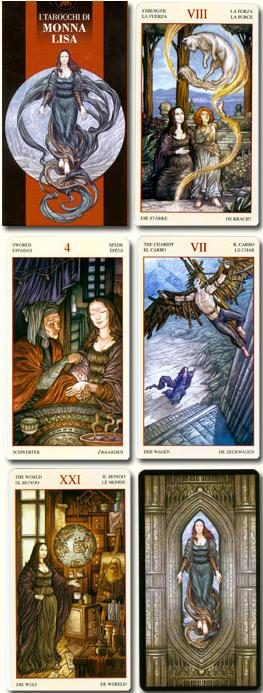
Candida Martinelli's Italophile Site

Main
Page This family-friendly site celebrates Italian culture for the enjoyment of children and
adults. Site-Overview
The Golden Tarot of
Botticelli, Alida's most
beautiful offering. Alida is an
on-line store based in The Republic of San Marino. They ship
Italian playing cards (Tarot, Regional, Historical) all over the world.
The cards are reasonably priced, and shipping is fast (airmail) and very
reasonably priced!
I think the cards are too beautiful to play with and
should all be framed. I feature many of them here on this page.
Click through to their store (in Italian and English) to view their
full, beautiful selection. I've
purchased cards from them without any problems whatsoever, and am very
happy with the GORGEOUS cards!
Tarot Deck of Venice
Tarot decks are often themed, and sometime have very unique themes.
Alida even offers one based on the movies of Italian director Dario Fo!
The Monna Lisa Tarot Deck
Tarot Deck of the Angels
African-American Tarot Deck
Leonardo's Inventions Tarot Deck
The Circle of Life Tarot Deck
The highly symbolic, and classic, Tarot of Marseille Playing cards began where paper began: in China. They
started with representations of the domino symbols. Cards
moved roughly via India, Persia, Egypt, and then on to Europe. The earliest decks where commissioned from artists, who hand
painted the suits onto card stock. That meant they decks were
expensive and generally exclusive to the wealthy. Along with
board games, they were popular gifts for princes to offer allies. Playing cards take off in Europe in the 1400s. That
coincides with primitive paper and a printing process that
transferred an image to paper using ink on a wooden stamp (woodcut).
The ink image was then painted by hand to create a colored deck. Early decks only survive in fragments, mainly because they were
made of paper, and well used by players. Even today's decks,
coated in plastic, don't last forever. Just think how many
decks your own family has gone through. Regional variations exist in most places, but none so much as in
Italy (nearly one official deck per region). This is likely due to Italy's late unification, and the
popularity of card playing. Certain games are even linked to
certain regional decks. Generally speaking, the Italian card deck has 40 cards (1-7 and 3
face cards). But in the North of Italy, the standard 52 card
French deck is common. The Neapolitan and Sicilian are probably the
best known Italian regional cards outside of Italy, because of the
large number of emigrants from those areas. I explain the most common Italian card games on separate pages on
this site: Tarot cards were even more popular in Europe in the earliest card
days (the late 1400s) than the other types of card deck, and they
were specifically used for trick-taking card games. In Italy, they were called Triomfi (Triumphs), which was
later used for the Trump cards in trick-taking games. The
early decks were custom made for princes, and varied much in design. The earliest recorded commission of a custom
Triomfi deck was for the Visconti of Milan. This deck is based
on the original. Almost as soon as they were used for game-playing, Tarot cards,
Tarocchi, were used for fortune-telling. But today, the
card-playing Tarot cards often differ from the fortune-telling Tarot
cards. Game cards clearly detail a card's suit and value.
Fortune-telling cards often feature elaborate images related to the
fortune-telling meaning of a card. The Tarot game deck is a 78 card deck: Tarocchi, or Tarot or Tarock, is a card game that is still played
in Europe. It is a standard trick-taking game: But in Italy, it is mainly the
Tarocco Bolognese
Ottocento that is still played, and Pagat has a wonderful page
dedicated to that complex game. Tarocco Bolognese (or Tarocchino, because it
has only 62 cards, instead of the full 78 cards) The fortune-telling deck is the same as for Tarot card games, but is often more
elaborate in it's decoration. The fortune-telling deck is a 78 card deck: For those of you interested in the names and meanings of the
Major and Lesser Arcana cards, I suggest a visit to Wikipedia:
Tarot Reading Tarot cards are often valued solely for their artistic qualities.
Some decks are sold as works of art, and include only the 22 Major Arcana cards, suitable for framing. The Golden Tarot of Botticelli
Mestieri dell'Uomo
Musici e Strumenti
Musicali
Jeu de Drapeaux
And Alida carries the
double deck boxed sets by Piatnik that shape the face card figures
in historical guise, like this one, called Glorious America (from
their Bridge Collection).

Italian Playing
Cards - Tarot - Tarocchi
![]()

Introduction
Regional Cards and Games
Tarot Cards - Tarocchi
Tarot Card Games
Tarot Cards for Predicting the Future
Some of Alida's Special Decks
Bologna 1680, The Professions of Man (Historical Cards Section)
Roma 1716, Musicians and Musical Instruments
(Historical Cards Section)
1814 - Paris, Game of the Flag, where the card value and suit are
shown with flag scenes
(Historical Cards Section)